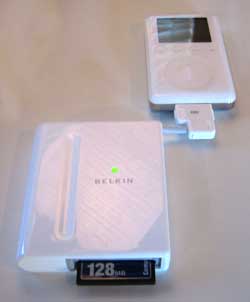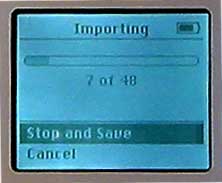 |
 |
 |
Saturday, October 25, 2003
Posted 9:51 AM
Rethinking a Recommendation: Should You Buy Belkin's Media Reader for iPod?
Over at the fine Digital Photography Review site, forum members are continuing to grouse about slow transfers from the Media Reader.
It appears they have something to complain about.
The Media Reader appears to have very slow transfer rates that become unacceptably slow if you're working with huge image files. Based on this, I've revamped my conclusion and recommendation for the Media Reader.
My current stance is thus: If you work with high-capacity memory cards (512MB and up) and very large files (images in RAW format), you may want to pass on the Belkin Media Reader, at least until Belkin addresses what appear to be some genuine performance problems.
However, if you work with smaller-capacity cards and smaller files (for example, JPEG images from cameras that shoot 4-megapixels or less), you probably won't be bothered by the Media Reader's slow transfer speeds.
Here's hoping Belkin or Apple or somebody releases a firmware update that makes this appealing little device a winner for every digital photographer.
Friday, October 24, 2003
Posted 11:05 AM
Hands On with Belkin's iPod Media Reader
First, the iPod was a music player. Then it became an address book and calendar, too.
Now it's also a photo shoebox. Belkin's $99 Media Reader for iPod enables Apple's more-than-a-music-player to store photos from all common digital camera memory cards.
Fill up your memory card while you're in the field? Simply copy its photos to your iPod, then erase the card and start shooting again. When you get back to your Mac, connect the iPod and copy the photos into your iPhoto library. It's a great alternative to taking a laptop on your next vacation just to have a place to park your photos.
I've been working with the Media Reader for iPod, and so far, I love it -- even though I haven't yet succeeded in getting iPhoto to automatically import photos from my iPod.
Here's my story.
Step 1: Installing iPod Update 2.1
The Media Reader for iPod requires iPod Update 2.1, so my first step was to install it. After reading some horror stories on Apple's iPod discussion boards, I was worried that installing the update would render my iPod unusable.
Fortunately, my fears were unfounded. The update installed flawlessly, and after a minute or so, my iPod was ready to connect to the Media Reader. (Tip: Before installing the iPod update, I rebooted my iPod by holding down its Menu and play/pause button for a few seconds. I don't know whether this helped ensure a reliable update, but it sure didn't hurt.)
Step 2: Set Up the Media Reader
The Media Reader is slightly larger than the iPod itself. All glossy and white, it's an attractive little gizmo that complements the iPod nicely. The back of the reader contains a retractable cable that attaches to the dock connector on the bottom of the iPod. Alongside the retractable connector is a door that houses four AAA batteries, which are included.
Around front is a little garage door: slide it open to reveal slots that can accommodate a Compact Flash card (including an IBM MicroDrive), a Memory Stick, a SmartMedia card, and more (see the full list at Belkin's site).
The Media Reader doesn't require you to install any additional software on your Mac.
Step 3: Copy Some Photos
For my tests, I copied some photos and movies taken with a Canon PowerShot S330. I removed the Compact Flash card from the camera, inserted it into the Memory Reader, and my iPod displayed a screen listing how many photos were on the card and containing an Import command.
I chose the Import command, and the iPod began bringing the photos in. During the import process, a small indicator light on the Media Reader flashed. (This light also serves as a low-battery notice, turning from green to amber when the juice is low.)
In this test, I was importing two-megapixel images. On average, each image took between one and three seconds to import. That isn't exactly speedy, but remember, Compact Flash cards are a relatively slow form of memory.
When all of the photos had been transferred to the iPod, the iPod's screen changed to include an Erase Card command. When you're out in the field, you'd use this command to wipe the card clean in preparation for another shooting session. (You could, of course, also erase the card using your camera's menus.)
After importing one set of photos, I inserted a second Compact Flash card into the Media Reader and imported its images, too.
After the Import
After you import some photos, the iPod's Extras menu gains a new command: Photo Import. Choose this command, and the iPod lists each roll that you've imported. The rolls are simply named numerically, and the number of photos in each roll appears after its name, as in Roll #1 (23), Roll #2 (15), Roll #3 (56).
If you choose a roll's name, the iPod's screen changes to display the number of photos in that roll, the date you imported them, and the amount of disk space they use. This screen also contains a Delete Roll command.
At no time can you actually view the photos on your iPod's screen. The Media Reader turns the iPod into a photo shoebox, not a tiny picture frame.
From iPod to iPhoto
It's great having all that photo storage on your iPod, but at some point, you're going to want to move the photos into your iPhoto library.
Here's where I've encountered a potential glitch, and I'm still researching the answer. From reading other reviews and Belkin's own support documents, I'm under the impression that you can use iPhoto or Mac OS X's Image Capture program to bring photos in from a connected iPod.
This isn't working for me. Neither iPhoto nor Image Capture recognizes the iPod, and I've tried it on two different machines. Stay tuned for updates.
For now, I'm copying images manually. When you activate the iPod's FireWire disk mode, you see a folder named DCIM. (This is a standard naming scheme that virtually all modern digital cameras use.) When I dragged that folder into my iPhoto window, iPhoto imported the photos, storing each set of photos in its own roll, just as you'd expect.
Heid's Buying Advice
Although the iPhoto-import issue still has me stymied, I'm impressed with the Belkin Media Reader for iPod. It's beautifully integrated with the iPod's software -- if you know how to navigate the iPod's menus, you know how to use the Media Reader.
I'll post an update regarding the iPhoto-import issue as soon I as learn something. In the meantime, I recommend the Belkin Media Reader for iPod with some reservations, as noted in the posting above.
UPDATE: According to a discussion on Digital Photography Review's Web site, the Media Reader is painfully slow when transferring large files. Belkin appears to have acknowledged a problem, though when and if any problem will be resolved is still uncertain. Meantime, if you plan to transfer extremely large files -- for example, high-resolution photos in RAW format -- you may want to think twice about the Media Reader. Posted at noon Pacific time, October 24.
I also recommend my free iTunes 4 and iTunes Music Store update: a PDF file containing 18 full-color pages in the same gorgeous design as The Macintosh iLife book. Get your update here.
04/20/2003 - 04/26/2003
04/27/2003 - 05/03/2003
05/04/2003 - 05/10/2003
05/11/2003 - 05/17/2003
05/18/2003 - 05/24/2003
05/25/2003 - 05/31/2003
06/01/2003 - 06/07/2003
06/08/2003 - 06/14/2003
06/15/2003 - 06/21/2003
06/22/2003 - 06/28/2003
07/06/2003 - 07/12/2003
07/13/2003 - 07/19/2003
07/20/2003 - 07/26/2003
08/03/2003 - 08/09/2003
10/05/2003 - 10/11/2003
10/12/2003 - 10/18/2003
10/19/2003 - 10/25/2003
11/02/2003 - 11/08/2003
11/30/2003 - 12/06/2003
12/07/2003 - 12/13/2003
12/21/2003 - 12/27/2003
12/28/2003 - 01/03/2004
01/04/2004 - 01/10/2004
01/18/2004 - 01/24/2004
01/25/2004 - 01/31/2004
02/01/2004 - 02/07/2004
03/07/2004 - 03/13/2004
03/21/2004 - 03/27/2004
04/11/2004 - 04/17/2004
04/18/2004 - 04/24/2004
04/25/2004 - 05/01/2004
05/02/2004 - 05/08/2004
05/09/2004 - 05/15/2004
05/16/2004 - 05/22/2004
05/23/2004 - 05/29/2004
05/30/2004 - 06/05/2004
06/06/2004 - 06/12/2004
06/13/2004 - 06/19/2004
06/20/2004 - 06/26/2004
06/27/2004 - 07/03/2004
07/11/2004 - 07/17/2004
07/18/2004 - 07/24/2004
07/25/2004 - 07/31/2004
08/01/2004 - 08/07/2004
08/08/2004 - 08/14/2004
08/22/2004 - 08/28/2004
08/29/2004 - 09/04/2004
09/05/2004 - 09/11/2004
09/12/2004 - 09/18/2004
09/19/2004 - 09/25/2004
09/26/2004 - 10/02/2004
10/03/2004 - 10/09/2004
10/24/2004 - 10/30/2004
10/31/2004 - 11/06/2004
11/07/2004 - 11/13/2004
11/14/2004 - 11/20/2004
11/28/2004 - 12/04/2004
12/05/2004 - 12/11/2004
12/12/2004 - 12/18/2004
12/19/2004 - 12/25/2004
01/09/2005 - 01/15/2005
01/16/2005 - 01/22/2005
01/23/2005 - 01/29/2005
01/30/2005 - 02/05/2005
02/06/2005 - 02/12/2005
02/13/2005 - 02/19/2005
02/27/2005 - 03/05/2005
03/06/2005 - 03/12/2005
03/27/2005 - 04/02/2005
04/03/2005 - 04/09/2005
04/10/2005 - 04/16/2005
04/17/2005 - 04/23/2005
04/24/2005 - 04/30/2005
05/01/2005 - 05/07/2005
05/08/2005 - 05/14/2005
05/15/2005 - 05/21/2005
05/22/2005 - 05/28/2005
05/29/2005 - 06/04/2005
06/05/2005 - 06/11/2005
06/12/2005 - 06/18/2005
Really old stuff (before February 2003)

